Blog
How to Record Piano - Full Guide and Tips for at Home or in the Studio
14 Jun '2024
Learn how to mic up and record a piano – whether a grand or an upright model – so you can get great and dependable results

Want to start experimenting with recording Piano, or running into trouble getting your piano recordings up to a professional, radio-ready standard? In this article, we explore some of the key equipment and setup decisions you should make when recording a Piano at home or in the studio.
What microphone is best for recording Piano?
As far as “how long is a piece of string?” questions go, this one is up there. There are many factors at play when deciding the best microphone for recording piano, such as your recording environment, the tone of your instrument and the character you want it to adopt in the mix.
Ultimately, the right microphone is the one that sounds best for your needs. That said, there are a few considerations that are worth taking into account when deciding on which microphone is the most suitable for the job.
Microphone types
As the two most common types of microphones, dynamic and condenser microphones are both well capable of recording piano, but each excels in different areas. For example, dynamic mics are less sensitive than condensers, making them ideally suited to recording in live environments or with other instruments nearby.
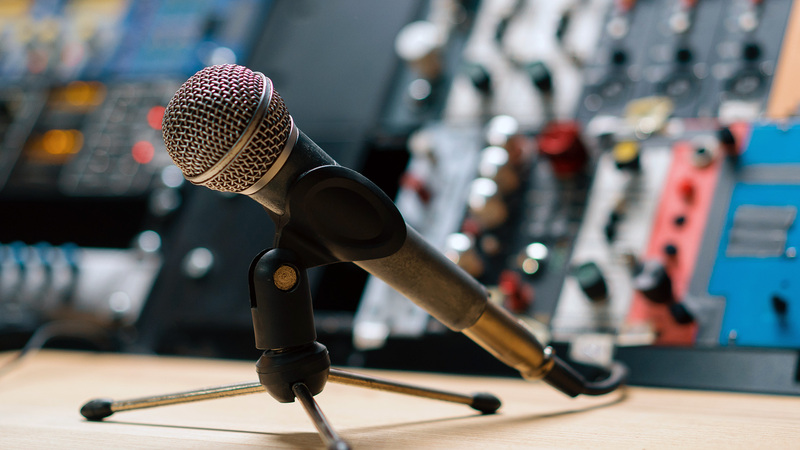
Condenser mics, on the other hand, are more sensitive than dynamic mics, and they tend to possess more clarity in high frequencies. This might make them a great option if you want to emphasise the brighter tones of your piano. Equally, if your piano is already very bright or you are recording piano across the entire frequency range, a condenser microphone may pronounce the upper frequencies in an undesirable way.
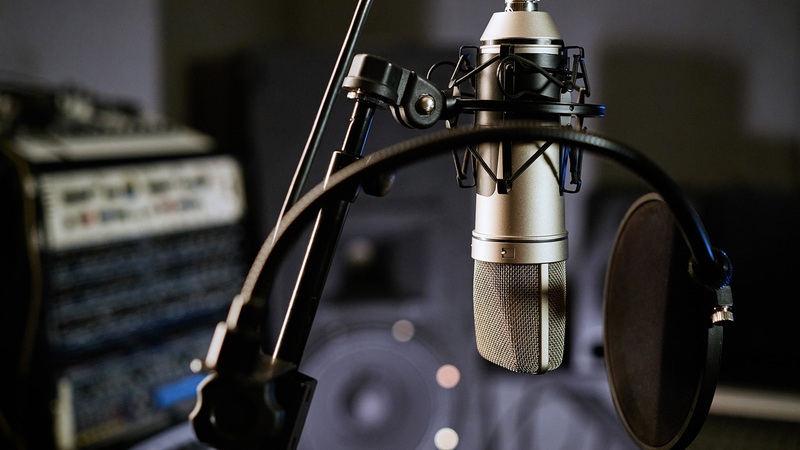
Considering your microphone’s frequency response
When we talk about condenser mics often being more sensitive to higher frequencies than dynamic mics, we’re generalising to a degree. If you want to really understand how your choice of microphone will affect the tone of your piano recording, you can check the frequency response chart of any given microphone.

This can help you to narrow down which mic is best suited for your needs. For example, if you know that your vocals have a lot of information around 5kHz, you may want to avoid using a microphone with a bump in the same area on your piano. Too much frequency content in this area may cause frequency masking and therefore a difficult mix.
How to record Piano
With piano recording equipment covered, let’s look at how to get the sound out of the piano and into your DAW.
How many microphones do you need to record Piano?
In the world of music production equipment, it’s easy to get carried away with thinking that more equals better, but that’s often not the case. In fact, you can achieve professional recordings with a single microphone – there are countless lead vocals in the worldwide charts that were recorded with a single mic.
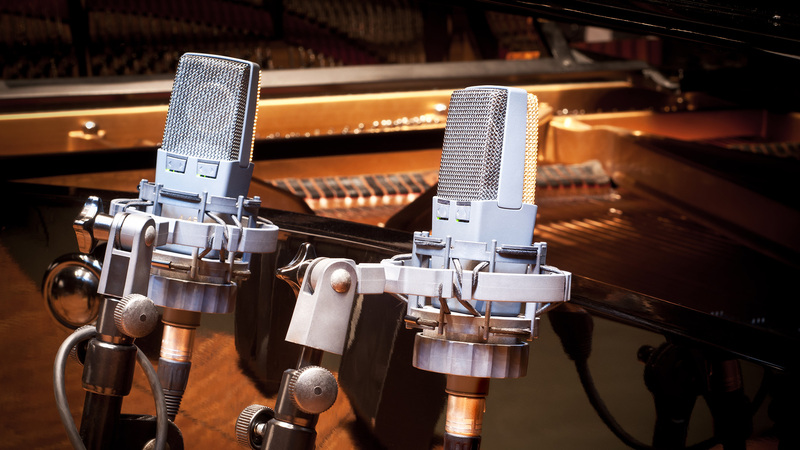
That doesn’t mean you can’t use more than one microphone, though, you just need to know why you’re choosing your recording technique and the implications for doing so. Using more microphones can help you to achieve a greater sense of realism in your recording, as well as more width. It can also give you greater control in the mixing process, as you can balance the levels of the different components of your piano.
One of the main implications of multi-miking any instrument is the potential for introducing phase issues that come with combining multiple audio signals.
Mic positioning for recording Piano
Given the size and weight of a piano, you probably can’t do much about where it’s positioned in your room. The good news is that with a basic understanding of mic placement, you can dramatically impact the tone and character of an instrument recording. This is particularly true of a piano, as many components form the overall sound such as the keys, hammers, strings or soundboard.
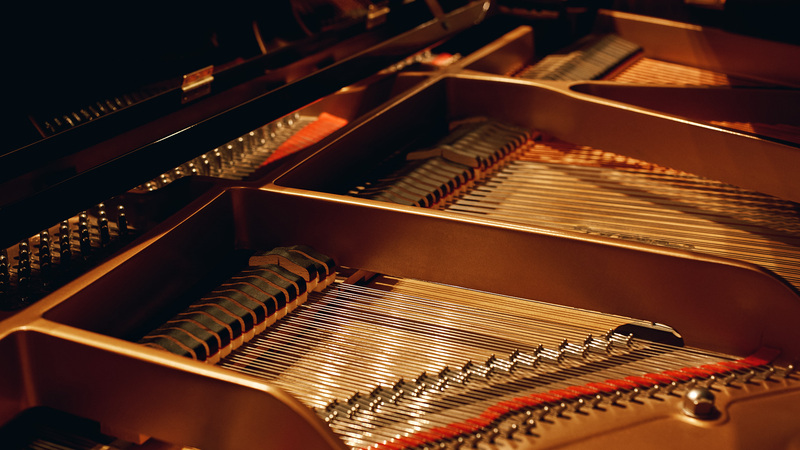
Placing your microphone nearer or towards any of these components will emphasise the volume of those sounds. You can use this to your advantage when deciding what kind of piano tone you’d like to achieve. For example, if you want a bright sound with a lot of transient information, try placing your microphone near where the hammers contact the strings.
On the other hand, if you want a more pronounced tonal part of the piano, placing your pianos away from the hammers and nearer the soundboard will help you to achieve that. Ultimately, things like piano tone, microphone choice and even playing style will influence the resulting recording, so it’s best to take some test recordings while you experiment with mic position.
Upright Piano
Over the Open Lid - Place a single mic or a pair of mics over the open lid of the piano. This setup captures a clear and natural sound.
Behind the Piano - Position stereo mics behind the pianist’s head. This technique captures the sound as if the listener is positioned right behind the player, providing a wide stereo field.
At the Soundboard - Place microphones at a distance of 6-8 inches from the soundboard, either spaced at each end or together in an X-Y pattern.
Under the Keyboard Panel - Remove the kickboard and place a mic at each end underneath the keyboard to capture a fuller sound.
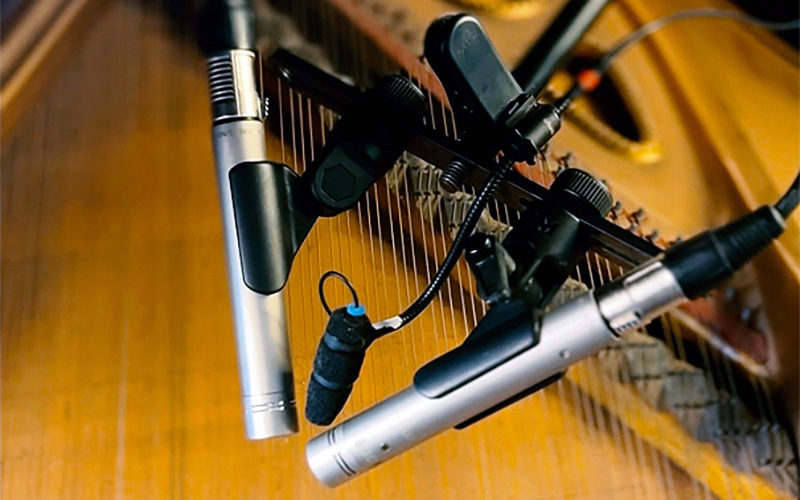
Grand Piano
X-Y Pair - Place a stereo pair in an X-Y or ORTF configuration above the strings or near the pianist’s head for a balanced sound.
Inside the Piano - Position one mic over the treble strings and one over the bass strings, each about 1-2 feet away. This setup captures the detailed nuances of the piano’s sound.
Outside the Lid - Place mics just outside the lid, pointing either towards the strings for a brighter sound or towards the lid for a mellower tone.
Close to the Hammers - For a more percussive and powerful sound, place mics close to the strings and hammers, especially useful for rock or blues styles.
No Piano? No problem with Loopmasters samples
As we’ve already mentioned, pianos are hardly the most practical instrument, so it doesn’t make you any less of a musician if you don’t have access to one. If you do find yourself pianoless and in need of the versatile and musical tones that they offer, Loopmasters boasts a huge library of high-quality piano samples for a range of genres and styles.
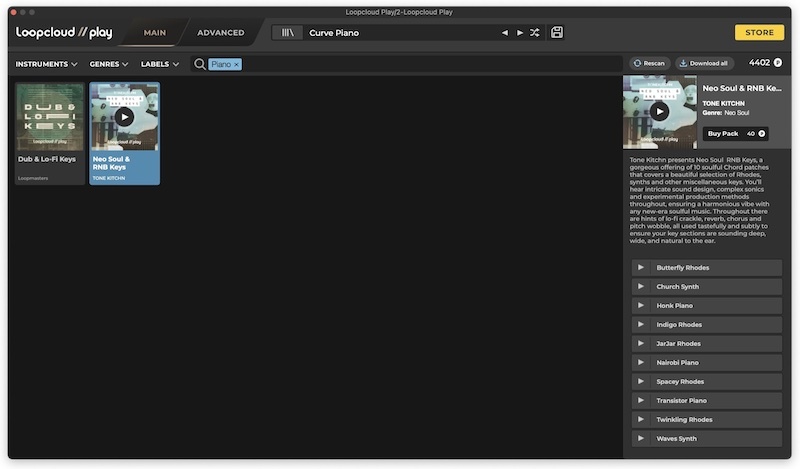
For those with access to a piano but looking for a more practical alternative, the Loopcloud PLAY plugin gives you the ability to select, edit and play a range of high-quality piano sounds with your MIDI keyboard. Whatever your skill level, studio setup or situation, your piano needs are met by the Loopcloud and Loopmasters platform.
Finding Piano samples on Loopmasters
With over four million royalty-free samples on the Loopmasters website, you’d expect it to be a challenge to find what you’re looking for. The reality is that professional-grade piano samples are just a couple of clicks away.
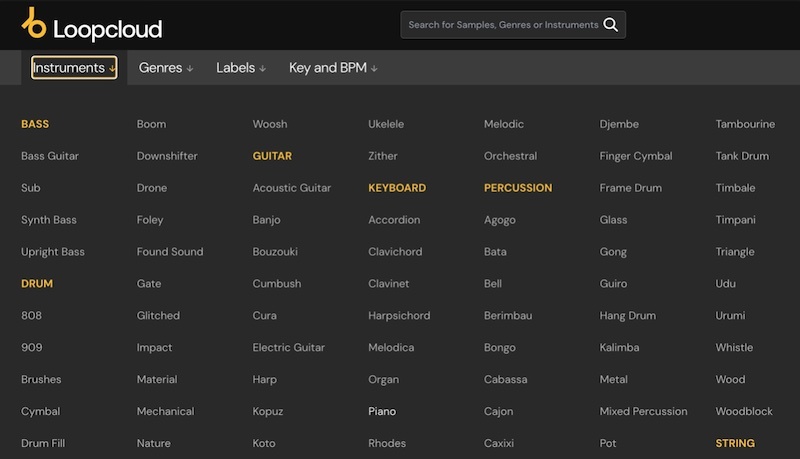
After opening the Instruments tab at the top of the Loopmasters home page, you can select Piano from the Keyboard category, and then you’re free to browse over 33,000 Piano one-shot samples and loops. From there, you can start to refine your search with Loopmasters’ Key and BPM tag functionality. Alternatively, you can filter by Loops or One Shot to hone in on the sound you’re looking for.
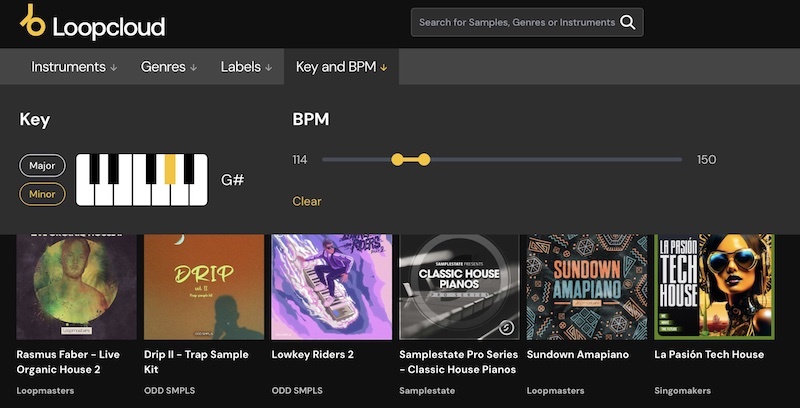
If you’re looking for a specific genre or style of piano, the genre tagging tab is your friend. Using the House genre tag, you can quickly find a pool of piano-filled sample packs such as the Classic Deep House 2 pack by UNDRGRND Sounds.
The pack contains over one thousand piano sounds comprised of raw one-shot samples ready to be loaded into your favourite sampler and played like a piano, as well as fully sequenced and processed piano loops designed to quickly add Beatport-ready melodic elements to your productions. If you’re working on a Balearic beat destined for an Ibiza sunrise, you won’t be disappointed by the contents of this sample pack.
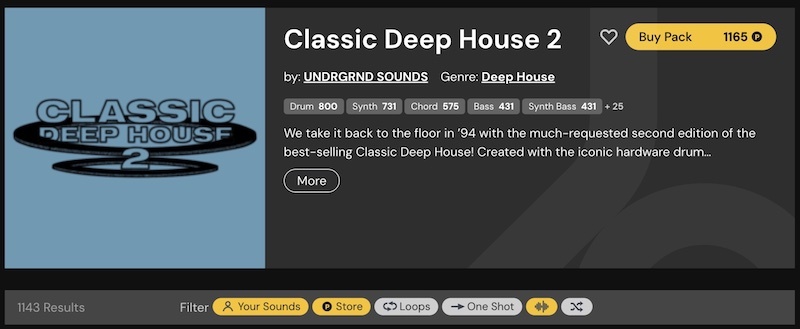
If you’re working on a particular style or aesthetic, check out some of the Loopcloud Presents sample packs, which focus on overall vibes as opposed to specific genres. For example, the Chilled Lo-Fi Melodics pack contains all manner of instrument samples, including piano, designed for downtempo and lo-fi music production. Alternatively, the Emotive Keys pack contains cinematic piano sounds with feeling and sentiment at their core.
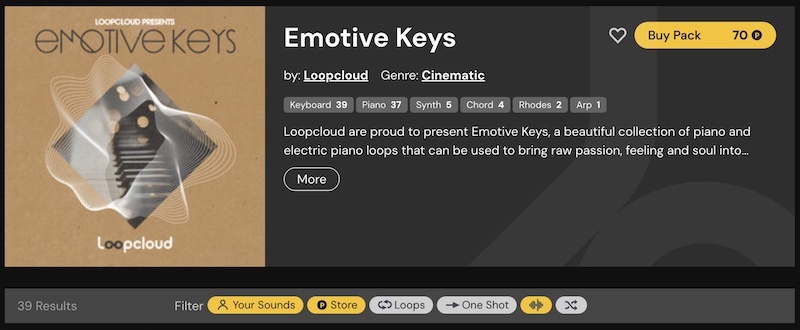
For more multi-purpose piano recordings, the Classical Piano sample pack by Frontline Producer is perfect for those seeking pure piano recordings in a traditional style. The pack contains 400 piano loops spanning a range of keys and tempos, making them suitable for all manner of contemporary music styles.
Whether you’re looking for piano melodies, chord progressions or arpeggios, this sample pack contains a range of performance styles and even includes some variations for infusing your productions with more realism and excitement.
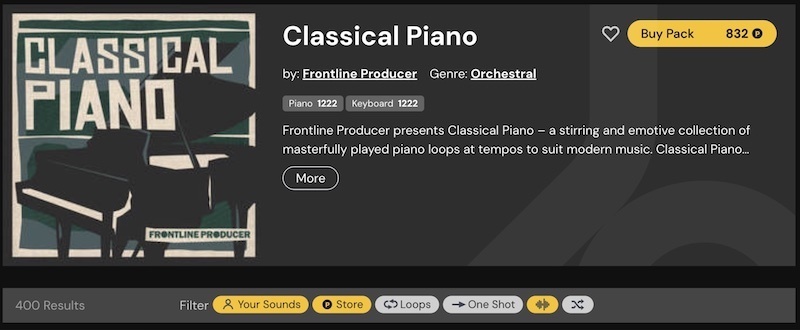
At the other end of the spectrum, the Creative Piano – Acoustic & Electric pack by 5Pin Media is all about twisted, warped and mangled piano recordings rather than piano for the purists. With almost 900 carefully crafted samples, this pack is the last word in experimental piano sounds.
5Pin Media are responsible for some of the most innovative sample packs on Loopmasters, and their Creative Piano pack is no exception. Using a range of boutique outboard gear, they’ve created a huge toolbox of sounds such as risers, pads, textures, rhythmic effects and atmospheres, destined for your next production.
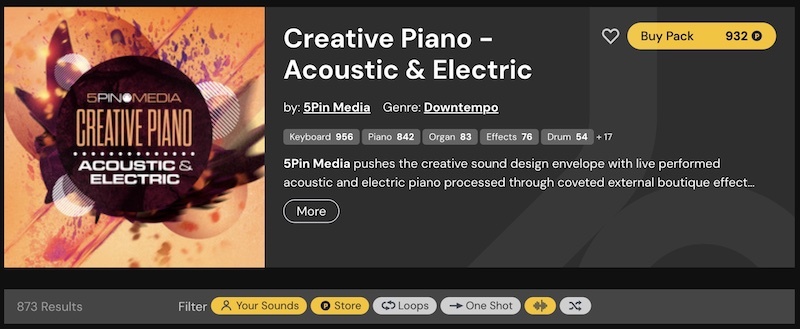
FAQs
Can you record a Piano with a phone?
Contrary to popular belief, you don’t need the world’s fanciest microphone to capture suitable recordings. Of course, if you’re hoping to capture highly detailed and transparent piano recordings, then you may want to invest in suitable recording equipment. In other cases, the immediacy and practicality of a mobile phone may make it the perfect recording device for your needs.
What microphone is best for recording Piano?
As with many music production techniques, there is no golden rule and no one-size-fits-all approach. With that in mind, the best microphone for recording piano is the one you have access to. If you have access to many microphones, then consider their type, frequency response and polar pattern, and then try to match the microphone up to how you want your piano to sound.
How to record an upright Piano?
An upright piano differs slightly to a grand piano in that the strings are vertical rather than horizontal, meaning the hammers take longer to return to their default position. Additionally, upright pianos are designed for domestic applications and therefore don’t project their sound as much as grand pianos. Taking this into account, you may wish to employ close-microphone recording techniques in order to capture the full tone of the piano.

